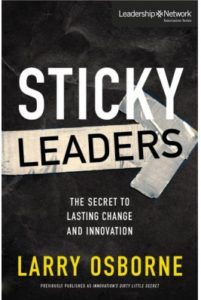Book Review: Sticky Leaders
 Reviewing Sticky Leaders, by Pastor Larry Osborne was a joy because the insights in this book are inspiring, important, and easy to understand. As a church consultant, I’ve read many wonderful books on church leadership, and Sticky Leaders does not disappoint. I highly recommend you read it. Here are four areas Osborne emphasizes that are worth considering.
Reviewing Sticky Leaders, by Pastor Larry Osborne was a joy because the insights in this book are inspiring, important, and easy to understand. As a church consultant, I’ve read many wonderful books on church leadership, and Sticky Leaders does not disappoint. I highly recommend you read it. Here are four areas Osborne emphasizes that are worth considering.
Innovation
Osborne introduces the concept of “serial innovators” – leaders who try new things, think outside the box, and take careful, calculated risks. He says, “Healthy organizations…can’t just focus on the past. They must also think about creating the future…” This calls for flexibility and innovation.
He says a genuine innovation must work and be widely accepted. The author gives the example of the Segway – the personal, two-wheeled motorized vehicle. Segway’s work. But they never became widely accepted,…except if you’re a mall cop. He states that if a “better” solution isn’t widely adopted, it’s an invention, but not an innovation.
Osborne also states that your church’s culture is far more important to the success or failure of a new idea than the brilliance of the idea. Some church cultures foster innovation. Others kill innovation.
Leadership
As a high-level leader himself, Osborne shares insights from his years of experience. He says leaders can’t avoid failure, but all failures are not equal. Good leaders keep failures from becoming fatal.
Osborne states that leaders have a bias for action and will accelerate the process of change and innovation within their organization. But he reminds his readers that nothing ever works as planned. Therefore, he stresses flexibility. He says to “plan in pencil.” He encourages leaders to keep their options open and to use the language of flexibility rather than certainty. To allow for mid-course corrections. To be willing to change as the facts change. To institute guiding principles rather than rigid policies.
Mission / Vision
Osborne says both mission and vision are important but there’s a difference between the two. A mission statement explains why your church exists. A vision statement is the narrative that describes what success is supposed to look like, says Osborne.
While I don’t completely agree with these definitions, I do whole heartedly agree that a mission statement must be “ruthlessly honest, widely known, and broadly accepted.” And I love his thoughts that missional clarity takes laser-like focus. He states, “If something doesn’t take us toward our mission, it takes us away from our mission, even if it’s a great idea.” That’s so good I tweeted it! He adds that it’s hard to hit the bullseye when you’ve got a moving target, and explains the power of a great mission statement to help focus plans, programs and priorities.
Osborne says that a clear mission statement without detailed vision of what success looks like leads to a confused and splintered team. But a detailed vision without a clear mission statement leads to lots of activity with no way to measure success.
Breaking Through Barriers
Osborne says that God’s will can be thought of as having three components. What? When? And How?
“What” refers to a good idea. “When” is about right timing. “How” is proper execution. But then he poses a difficult question. He asks what happens when great effort, improved efficiency, and better quality don’t fix the problem. What happens when you “hit the wall?”
He reminds readers that what used to work well in churches often no longer works well – or no longer works at all. Organizational structures often get outgrown, or unexpected cultural shifts happen. He says that churches “can unwittingly turn a method into a core value and end up holding on to old methods and strategies long after the culture has abandoned them.”
In these difficult situations, when you’ve hit the wall, Osborne boldly calls leaders to embrace innovation and change, and look to new ideas.
He calls for organizational change, especially when it comes to traditional structures. He says that traditions are the comfortable and expected way to do things. But if dysfunctional structures are not changed, “the organization will inevitably shrink to a size that perfectly fits its policies, procedures and structure.”
If you’re a church leader wanting to maximize the kingdom-impact of your church in today’s rapidly changing culture, Sticky Leaders is a must-read.